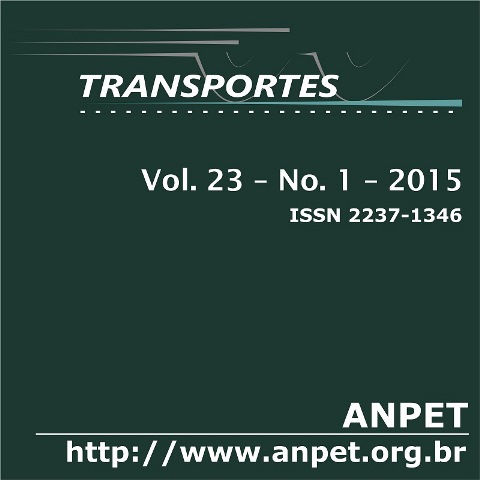Caracterização da utilização de painel de mensagem variável nos pontos de parada de ônibus de São Paulo
DOI:
https://doi.org/10.14295/transportes.v23i1.836Keywords:
Public transport, User information, Variable Message Sign.Abstract
The paper analyzes the quality of bus arrival predictions displayed in VMS – Variable Message Signs – in stops, as well as the factors influencing the use of this information by passengers. Two types of data were collected in two stops of a high frequency bus corridor in São Paulo. First, predictions displayed in panels and the effective vehicle arrivals at stops were recorded, which allowed the analysis of the quality of the information provided. Second, interviews were conducted with bus users about their use of the VMSs. Results indicate that the (objective) quality of the information, as well as the quality perceived by users can be considered good. Estimation of a binomial logit model allowed the identification of the importance of user socioeconomic and system utilization characteristics on the likelihood of using the information in the display. Users under 60 or having higher instruction levels have greater probability of using the VMS, as well as individuals using bus service more frequently and those served by more than one line, who can use the information to decide which bus to board.Downloads
References
Ben-Elia, E.; Di Pace, R.; Bifulco, G. N.; Shiftan, Y. (2013) The impact of travel information’s accuracy on route-choice. Trans-portation Research Part C, v. 26, p. 146-159.
Bierlaire, M. (2003) Biogeme: a free package for the estimation of discrete choice models. In: 3rd SWISS Transportation Research Conference. Conference Paper. Ascona, 2003.
Bonsall, P. Traveller behavior: decision-making in an unpredict-able world. Journal of Intelligent Transportation Systems, v. 8, n. 1, p. 45-60.
Chorus, C. G.; Arentze, T. A.; Molin, E. J. E. (2006a) The value of travel information: decision strategy-specific conceptualizations and numerical examples. Transportation Research Part B, v. 40, n. 6, p. 504-519. DOI: 10.1016/j.trb.2005.08.002
Chorus, C. G.; Molin, E. J. E.; Van Wee, B. (2006b) Use and effects of advanced traveller information services (ATIS): a review of the literature. Transport Reviews, v. 26, n. 2, p. 127-149. DOI: 10.1080/01441640500333677
Dziekan, K.; Kottenhoff, K. (2007) Dynamic at-stop real-time information displays for public transport: effects on customers. Transportation Research Part A, v. 41, n. 6, p. 489-501. DOI: 10.1016/j.tra.2006.11.006
Ettema, D.; Timmermans, H. (2006) Costs of travel time uncertainty and benefits of travel time information: conceptual model and numerical examples. Transportation Research Part C, v. 14, n. 5, p. 335-350. DOI: 10.1016/j.trc.2006.09.001
Ferreira, M. L. (2012) Olho Vivo – Sistema de informação on-line ao usuário do transporte coletivo na cidade de São Paulo. Coletivo – Revista Técnica da SPTrans, n. 1, p.120-145.
Larsen, O. I.; Sunde, Ø. (2008) Waiting time and the role and value of information in scheduled transport. Research in Transportation Economics, v. 23, n. 1, p. 41-52. DOI: 10.1016/j.retrec.2008.10.005
TRB (2003) Real-time Bus Arrival Information Systems: A Synthesis of Transport Practice. Transportation Research Board, Washington D.C..
Whately, I. M. (2012) O Papel dos Ônibus nos Transportes Públicos de São Paulo. Coletivo – Revista Técnica da SPTrans n. 1, p.18-33.
Downloads
Published
How to Cite
Issue
Section
License
Authors who submit papers for publication by TRANSPORTES agree to the following terms:
- The authors retain the copyright and grant Transportes the right of first publication of the manuscript, without any financial charge, and waive any other remuneration for its publication by ANPET.
- Upon publication by Transportes, the manuscript is automatically licensed under the Creative Commons License CC BY 4.0 license. This license permits the work to be shared with proper attribution to the authors and its original publication in this journal.
- Authors are authorized to enter into additional separate contracts for the non-exclusive distribution of the version of the manuscript published in this journal (e.g., publishing in an institutional repository or as a book chapter), with recognition of the initial publication in this journal, provided that such a contract does not imply an endorsement of the content of the manuscript or the new medium by ANPET.
- Authors are permitted and encouraged to publish and distribute their work online (e.g., in institutional repositories or on their personal websites) after the editorial process is complete. As Transportes provides open access to all published issues, authors are encouraged to use links to the DOI of their article in these cases.
- Authors guarantee that they have obtained the necessary authorization from their employers for the transfer of rights under this agreement, if these employers hold any copyright over the manuscript. Additionally, authors assume all responsibility for any copyright infringements by these employers, releasing ANPET and Transportes from any responsibility in this regard.
- Authors assume full responsibility for the content of the manuscript, including the necessary and appropriate authorizations for the disclosure of collected data and obtained results, releasing ANPET and Transportes from any responsibility in this regard.










